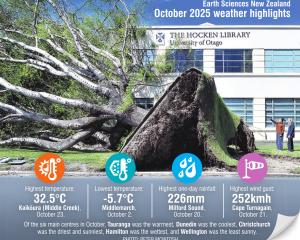Declining student numbers at the University of Otago last year were ‘‘overwhelmingly'' concentrated in the commerce and humanities division.
Chief financial officer Sharon van Turnhout confirmed the previously forecast 2.2% drop in student numbers to 18,416 equivalent full time students (Efts) last year from 18,830 in 2014 in a report tabled at the latest university council meeting.
This comes as the Otago Daily Times understands signs, including demand at halls of residences, are pointing towards a more positive picture when it comes to student numbers this year.
However, the university typically releases current-year enrolment numbers at the April council meeting.
Ms van Turnhout said in the report declining student numbers last year were ‘‘overwhelmingly'' concentrated in the divisions of commerce and humanities, which fell of 4.7% (146 Efts) and 4.6% (237 Efts) respectively.
Science enrolments dropped 1% while health sciences enrolments rose 0.2%.
Overall, domestic enrolments decreased by 379 Efts (2.2%).
A small increase in returning student numbers, including postgraduate growth, was not enough to make up for a ‘‘sharp'' decline of 9.8% in first-year enrolments.
Key causes of the decline were a sharp reduction in the number of school leavers gaining university entrance, due to demographic factors and the impact of more stringent standards, buoyant labour market conditions and intensifying competition among universities for students.
Full-fee international enrolments declined by 35 Efts (2.5%), in part due to the ongoing pipeline effects of winding down of a number of contracts with overseas governments.
Positives in the international arena included significant growth in recruitment from the United States, which continued to be the country with the largest number of international enrolments at the university.
Ms van Turnhout praised the university's group operating surplus of $32.662million against a budget of $24.698million as a ‘‘very positive result''.
It represented a 5% return on external revenue, which exceeded the Tertiary Education Commission target of 3%.
The ‘‘main factor'' in the improvement against budget was lower consumables and general expenditure, which ended the year $4.279million below budget.
This drop was largely as a result of a concerted drive to reduce spending to make up for the drop in student numbers.
She noted externally funded research income, at $91.353million, had almost returned to the previous high levels of 2010, but that this did not materially affect the surplus, as the additional income was mostly offset by higher academic and general salaries.












